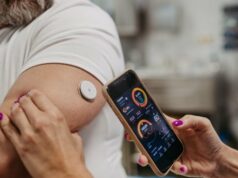An infant’s dummy fitted with a biosensor could be used to measure glucose levels of babies, researchers have said.
The sensor could be useful for helping to diagnose babies developing diabetes or to monitor glucose levels for babies that have been diagnosed with diabetes.
Babies that develop diabetes before the age of 9 months may have a type of diabetes known as neonatal diabetes. Other types of diabetes that can occur before the age of two years include type 1 diabetes and monogenetic types of diabetes which are often referred to as diabetes MODY.
Blood glucose tests require pricking the skin to draw a droplet of blood and continuous glucose monitoring (CGM) requires inserting a small sensor under the skin. Both of these methods present difficulties which the dummy-based sensor could help to bypass.
Finger-prick blood glucose tests are quite an invasive way of measuring glucose levels. While CGM does not require a finger-prick for each test, the largest part of a sensor device, which sits on top of the skin, is relatively large and cumbersome for a small infant and would need to be worn through the day and night.
The dummy-based sensor could get around some of these problems. The device incorporates a sensor into the nipple of the dummy, which picks up levels of glucose in the infant’s saliva. Glucose levels in saliva are known to rise and fall in a proportional way to blood glucose levels.
The device has been developed by researchers from the University of California San Diego (UCSD). It works by catching some of the child’s saliva via a detection chamber within the dummy. There, an enzyme attached to an electrode strip reacts to glucose levels and sends an electrical signal to a wireless phone app.
So far, the technology has not been tested in babies, but adults have had the chance to wear a dummy to test out the device.
Adults with type 1 diabetes were selected to test out the pacifier, which was shown to detect changes in glucose concentrations in the participants’ saliva before and after having a meal.
More thorough research will be needed to test how effective the device is in infants.
The research is published in the Analytical Chemistry journal.
Picture credit: ACS Publications








